Biometrics Authentication: Security and Privacy Implications Report
VerifiedAdded on 2021/05/30
|7
|1404
|100
Report
AI Summary
This report delves into the realm of biometrics for authentication, analyzing its role in modern security systems and the associated privacy concerns. It begins by defining biometrics and providing examples like fingerprint scanning and voice recognition. The report highlights the vulnerabilities of biometric technology, particularly face recognition, to spoofing attacks where intruders can exploit photos and videos to gain unauthorized access. It explores the history of biometric technology attacks, referencing research and the evolution of methods to protect systems. The report discusses the fingerprint template developed by Ratha as a means to reduce these vulnerabilities. The paper concludes that while biometrics enhance data protection, companies and organizations should incorporate biometric systems to prevent intrusions. Overall, the report emphasizes the need for robust biometric security measures to protect data and information from unauthorized access.
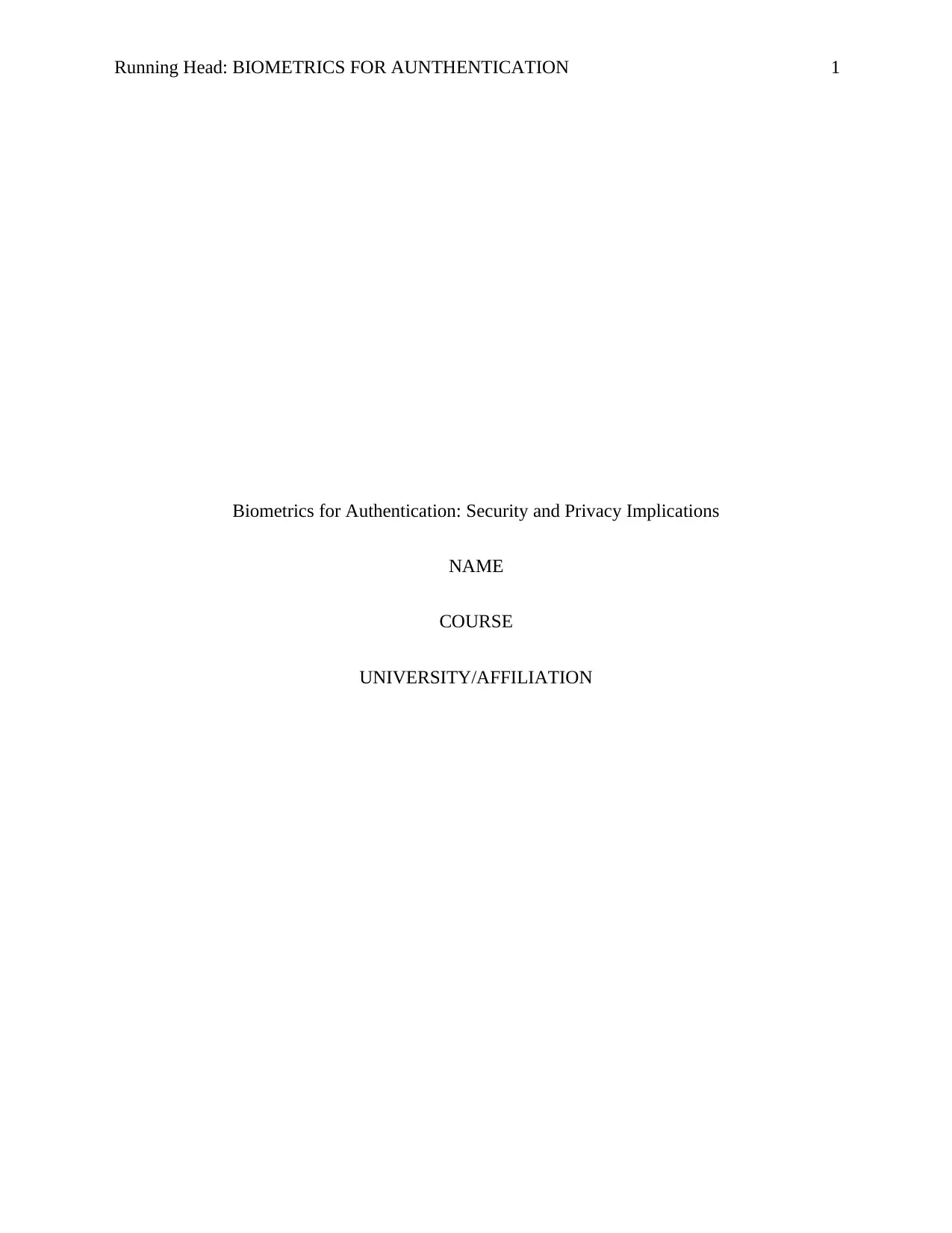
Running Head: BIOMETRICS FOR AUNTHENTICATION 1
Biometrics for Authentication: Security and Privacy Implications
NAME
COURSE
UNIVERSITY/AFFILIATION
Biometrics for Authentication: Security and Privacy Implications
NAME
COURSE
UNIVERSITY/AFFILIATION
Paraphrase This Document
Need a fresh take? Get an instant paraphrase of this document with our AI Paraphraser
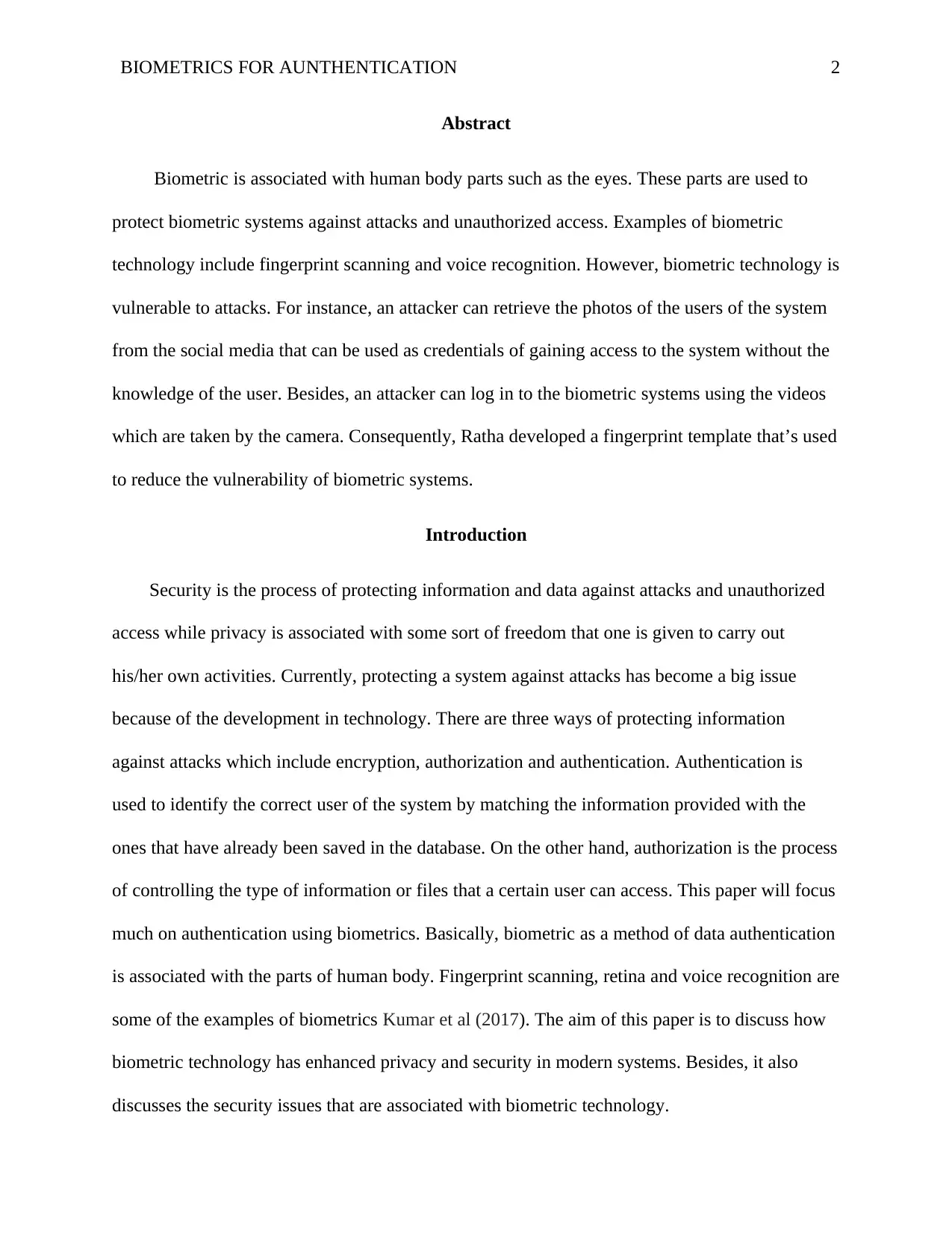
BIOMETRICS FOR AUNTHENTICATION 2
Abstract
Biometric is associated with human body parts such as the eyes. These parts are used to
protect biometric systems against attacks and unauthorized access. Examples of biometric
technology include fingerprint scanning and voice recognition. However, biometric technology is
vulnerable to attacks. For instance, an attacker can retrieve the photos of the users of the system
from the social media that can be used as credentials of gaining access to the system without the
knowledge of the user. Besides, an attacker can log in to the biometric systems using the videos
which are taken by the camera. Consequently, Ratha developed a fingerprint template that’s used
to reduce the vulnerability of biometric systems.
Introduction
Security is the process of protecting information and data against attacks and unauthorized
access while privacy is associated with some sort of freedom that one is given to carry out
his/her own activities. Currently, protecting a system against attacks has become a big issue
because of the development in technology. There are three ways of protecting information
against attacks which include encryption, authorization and authentication. Authentication is
used to identify the correct user of the system by matching the information provided with the
ones that have already been saved in the database. On the other hand, authorization is the process
of controlling the type of information or files that a certain user can access. This paper will focus
much on authentication using biometrics. Basically, biometric as a method of data authentication
is associated with the parts of human body. Fingerprint scanning, retina and voice recognition are
some of the examples of biometrics Kumar et al (2017). The aim of this paper is to discuss how
biometric technology has enhanced privacy and security in modern systems. Besides, it also
discusses the security issues that are associated with biometric technology.
Abstract
Biometric is associated with human body parts such as the eyes. These parts are used to
protect biometric systems against attacks and unauthorized access. Examples of biometric
technology include fingerprint scanning and voice recognition. However, biometric technology is
vulnerable to attacks. For instance, an attacker can retrieve the photos of the users of the system
from the social media that can be used as credentials of gaining access to the system without the
knowledge of the user. Besides, an attacker can log in to the biometric systems using the videos
which are taken by the camera. Consequently, Ratha developed a fingerprint template that’s used
to reduce the vulnerability of biometric systems.
Introduction
Security is the process of protecting information and data against attacks and unauthorized
access while privacy is associated with some sort of freedom that one is given to carry out
his/her own activities. Currently, protecting a system against attacks has become a big issue
because of the development in technology. There are three ways of protecting information
against attacks which include encryption, authorization and authentication. Authentication is
used to identify the correct user of the system by matching the information provided with the
ones that have already been saved in the database. On the other hand, authorization is the process
of controlling the type of information or files that a certain user can access. This paper will focus
much on authentication using biometrics. Basically, biometric as a method of data authentication
is associated with the parts of human body. Fingerprint scanning, retina and voice recognition are
some of the examples of biometrics Kumar et al (2017). The aim of this paper is to discuss how
biometric technology has enhanced privacy and security in modern systems. Besides, it also
discusses the security issues that are associated with biometric technology.
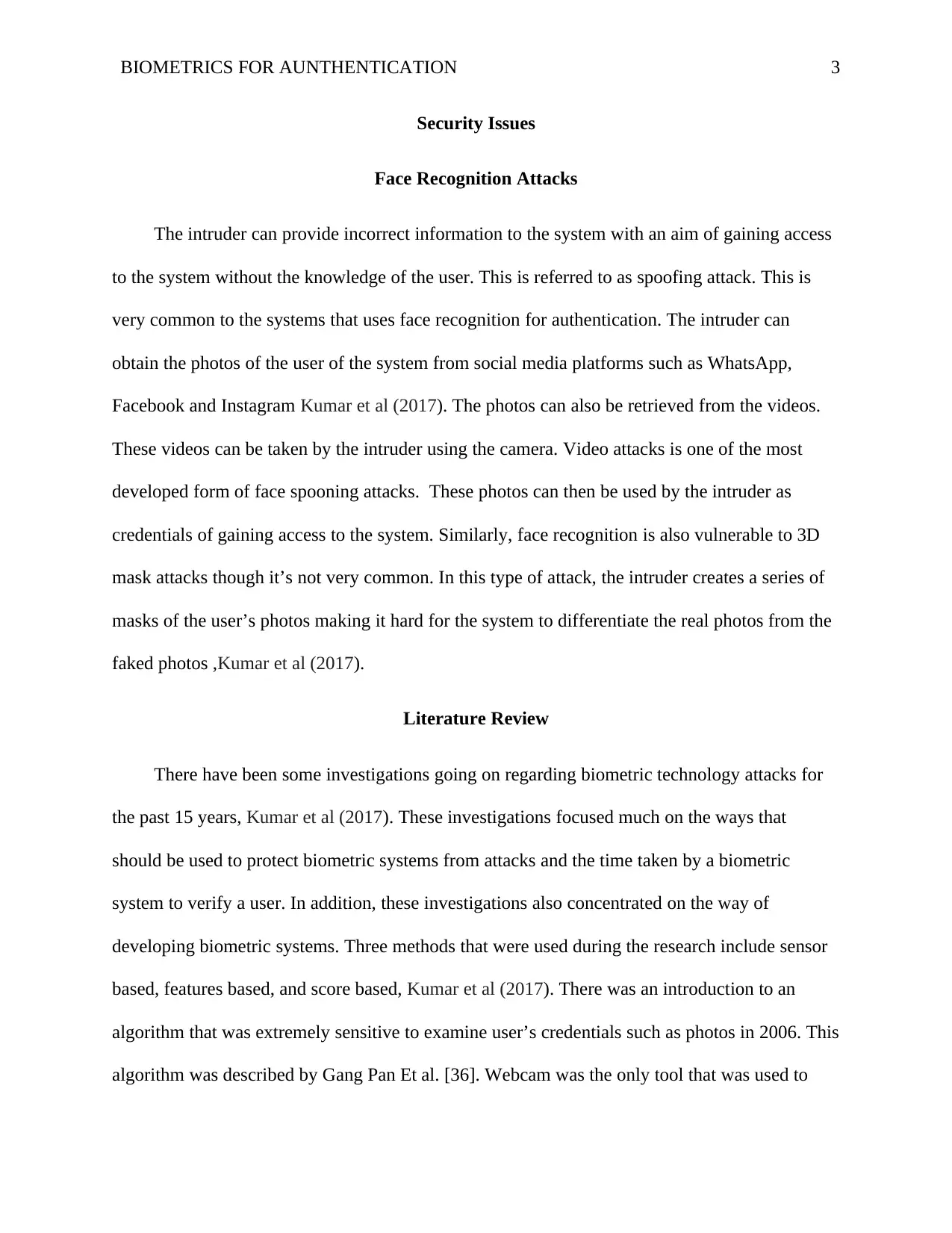
BIOMETRICS FOR AUNTHENTICATION 3
Security Issues
Face Recognition Attacks
The intruder can provide incorrect information to the system with an aim of gaining access
to the system without the knowledge of the user. This is referred to as spoofing attack. This is
very common to the systems that uses face recognition for authentication. The intruder can
obtain the photos of the user of the system from social media platforms such as WhatsApp,
Facebook and Instagram Kumar et al (2017). The photos can also be retrieved from the videos.
These videos can be taken by the intruder using the camera. Video attacks is one of the most
developed form of face spooning attacks. These photos can then be used by the intruder as
credentials of gaining access to the system. Similarly, face recognition is also vulnerable to 3D
mask attacks though it’s not very common. In this type of attack, the intruder creates a series of
masks of the user’s photos making it hard for the system to differentiate the real photos from the
faked photos ,Kumar et al (2017).
Literature Review
There have been some investigations going on regarding biometric technology attacks for
the past 15 years, Kumar et al (2017). These investigations focused much on the ways that
should be used to protect biometric systems from attacks and the time taken by a biometric
system to verify a user. In addition, these investigations also concentrated on the way of
developing biometric systems. Three methods that were used during the research include sensor
based, features based, and score based, Kumar et al (2017). There was an introduction to an
algorithm that was extremely sensitive to examine user’s credentials such as photos in 2006. This
algorithm was described by Gang Pan Et al. [36]. Webcam was the only tool that was used to
Security Issues
Face Recognition Attacks
The intruder can provide incorrect information to the system with an aim of gaining access
to the system without the knowledge of the user. This is referred to as spoofing attack. This is
very common to the systems that uses face recognition for authentication. The intruder can
obtain the photos of the user of the system from social media platforms such as WhatsApp,
Facebook and Instagram Kumar et al (2017). The photos can also be retrieved from the videos.
These videos can be taken by the intruder using the camera. Video attacks is one of the most
developed form of face spooning attacks. These photos can then be used by the intruder as
credentials of gaining access to the system. Similarly, face recognition is also vulnerable to 3D
mask attacks though it’s not very common. In this type of attack, the intruder creates a series of
masks of the user’s photos making it hard for the system to differentiate the real photos from the
faked photos ,Kumar et al (2017).
Literature Review
There have been some investigations going on regarding biometric technology attacks for
the past 15 years, Kumar et al (2017). These investigations focused much on the ways that
should be used to protect biometric systems from attacks and the time taken by a biometric
system to verify a user. In addition, these investigations also concentrated on the way of
developing biometric systems. Three methods that were used during the research include sensor
based, features based, and score based, Kumar et al (2017). There was an introduction to an
algorithm that was extremely sensitive to examine user’s credentials such as photos in 2006. This
algorithm was described by Gang Pan Et al. [36]. Webcam was the only tool that was used to
⊘ This is a preview!⊘
Do you want full access?
Subscribe today to unlock all pages.

Trusted by 1+ million students worldwide
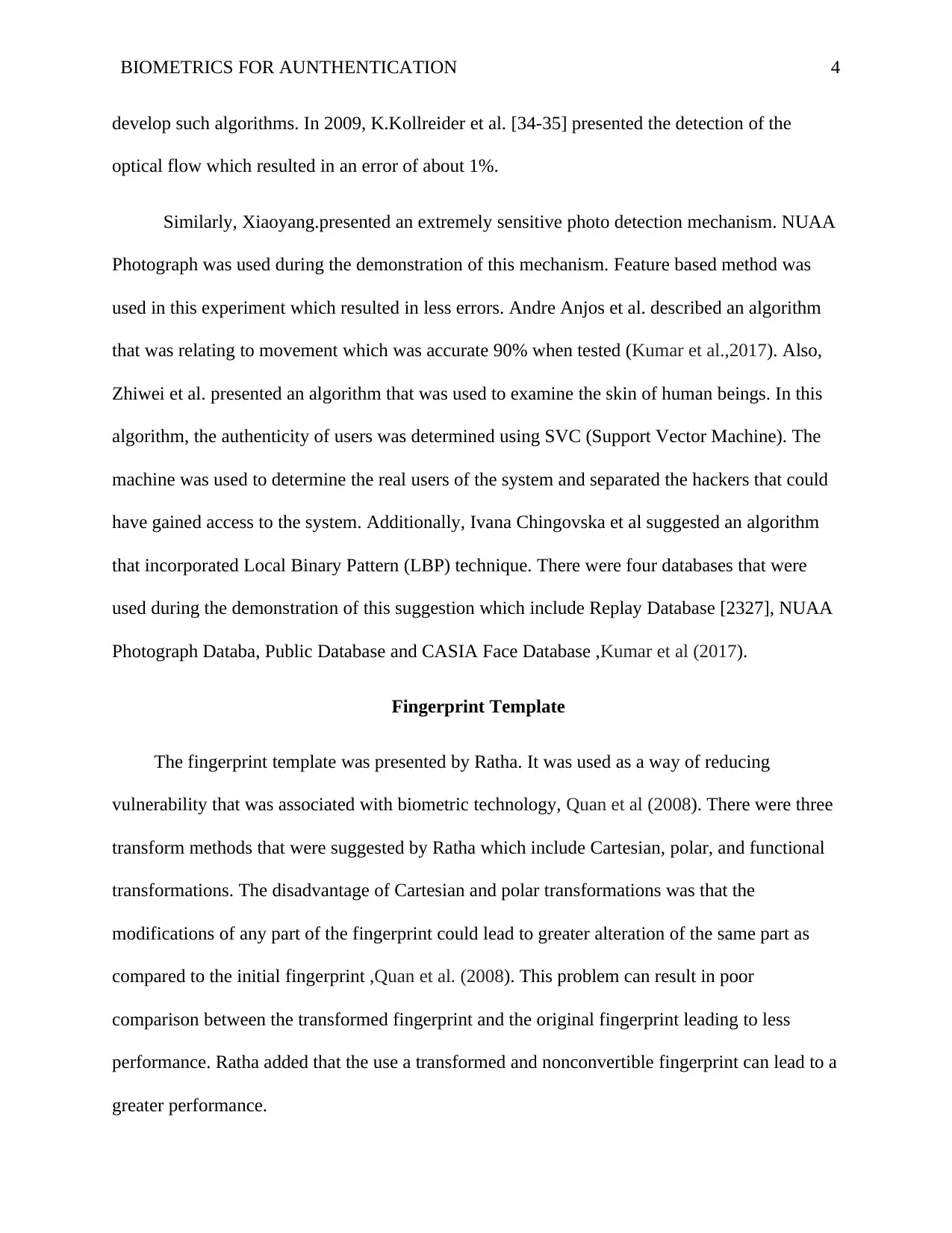
BIOMETRICS FOR AUNTHENTICATION 4
develop such algorithms. In 2009, K.Kollreider et al. [34-35] presented the detection of the
optical flow which resulted in an error of about 1%.
Similarly, Xiaoyang.presented an extremely sensitive photo detection mechanism. NUAA
Photograph was used during the demonstration of this mechanism. Feature based method was
used in this experiment which resulted in less errors. Andre Anjos et al. described an algorithm
that was relating to movement which was accurate 90% when tested (Kumar et al.,2017). Also,
Zhiwei et al. presented an algorithm that was used to examine the skin of human beings. In this
algorithm, the authenticity of users was determined using SVC (Support Vector Machine). The
machine was used to determine the real users of the system and separated the hackers that could
have gained access to the system. Additionally, Ivana Chingovska et al suggested an algorithm
that incorporated Local Binary Pattern (LBP) technique. There were four databases that were
used during the demonstration of this suggestion which include Replay Database [2327], NUAA
Photograph Databa, Public Database and CASIA Face Database ,Kumar et al (2017).
Fingerprint Template
The fingerprint template was presented by Ratha. It was used as a way of reducing
vulnerability that was associated with biometric technology, Quan et al (2008). There were three
transform methods that were suggested by Ratha which include Cartesian, polar, and functional
transformations. The disadvantage of Cartesian and polar transformations was that the
modifications of any part of the fingerprint could lead to greater alteration of the same part as
compared to the initial fingerprint ,Quan et al. (2008). This problem can result in poor
comparison between the transformed fingerprint and the original fingerprint leading to less
performance. Ratha added that the use a transformed and nonconvertible fingerprint can lead to a
greater performance.
develop such algorithms. In 2009, K.Kollreider et al. [34-35] presented the detection of the
optical flow which resulted in an error of about 1%.
Similarly, Xiaoyang.presented an extremely sensitive photo detection mechanism. NUAA
Photograph was used during the demonstration of this mechanism. Feature based method was
used in this experiment which resulted in less errors. Andre Anjos et al. described an algorithm
that was relating to movement which was accurate 90% when tested (Kumar et al.,2017). Also,
Zhiwei et al. presented an algorithm that was used to examine the skin of human beings. In this
algorithm, the authenticity of users was determined using SVC (Support Vector Machine). The
machine was used to determine the real users of the system and separated the hackers that could
have gained access to the system. Additionally, Ivana Chingovska et al suggested an algorithm
that incorporated Local Binary Pattern (LBP) technique. There were four databases that were
used during the demonstration of this suggestion which include Replay Database [2327], NUAA
Photograph Databa, Public Database and CASIA Face Database ,Kumar et al (2017).
Fingerprint Template
The fingerprint template was presented by Ratha. It was used as a way of reducing
vulnerability that was associated with biometric technology, Quan et al (2008). There were three
transform methods that were suggested by Ratha which include Cartesian, polar, and functional
transformations. The disadvantage of Cartesian and polar transformations was that the
modifications of any part of the fingerprint could lead to greater alteration of the same part as
compared to the initial fingerprint ,Quan et al. (2008). This problem can result in poor
comparison between the transformed fingerprint and the original fingerprint leading to less
performance. Ratha added that the use a transformed and nonconvertible fingerprint can lead to a
greater performance.
Paraphrase This Document
Need a fresh take? Get an instant paraphrase of this document with our AI Paraphraser
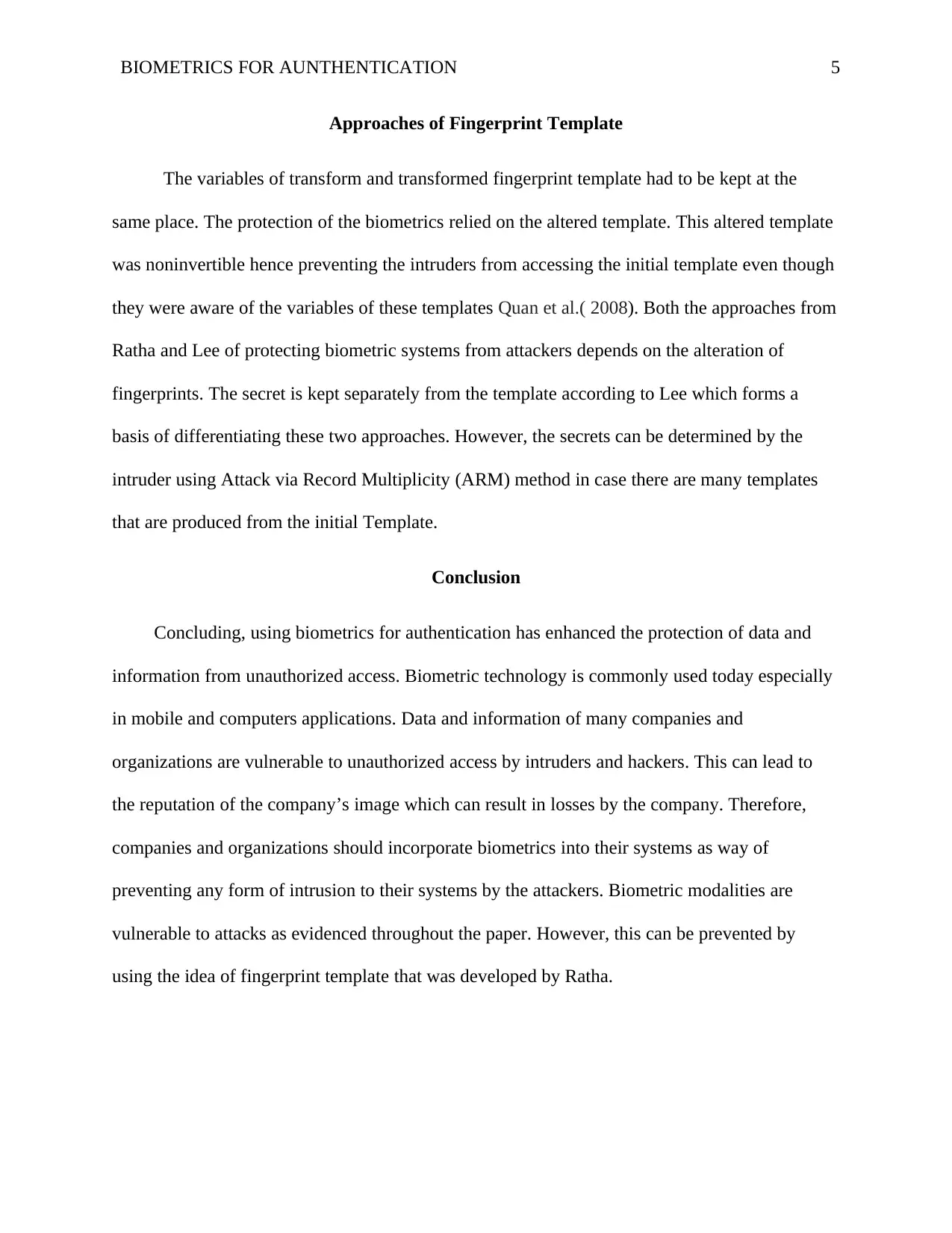
BIOMETRICS FOR AUNTHENTICATION 5
Approaches of Fingerprint Template
The variables of transform and transformed fingerprint template had to be kept at the
same place. The protection of the biometrics relied on the altered template. This altered template
was noninvertible hence preventing the intruders from accessing the initial template even though
they were aware of the variables of these templates Quan et al.( 2008). Both the approaches from
Ratha and Lee of protecting biometric systems from attackers depends on the alteration of
fingerprints. The secret is kept separately from the template according to Lee which forms a
basis of differentiating these two approaches. However, the secrets can be determined by the
intruder using Attack via Record Multiplicity (ARM) method in case there are many templates
that are produced from the initial Template.
Conclusion
Concluding, using biometrics for authentication has enhanced the protection of data and
information from unauthorized access. Biometric technology is commonly used today especially
in mobile and computers applications. Data and information of many companies and
organizations are vulnerable to unauthorized access by intruders and hackers. This can lead to
the reputation of the company’s image which can result in losses by the company. Therefore,
companies and organizations should incorporate biometrics into their systems as way of
preventing any form of intrusion to their systems by the attackers. Biometric modalities are
vulnerable to attacks as evidenced throughout the paper. However, this can be prevented by
using the idea of fingerprint template that was developed by Ratha.
Approaches of Fingerprint Template
The variables of transform and transformed fingerprint template had to be kept at the
same place. The protection of the biometrics relied on the altered template. This altered template
was noninvertible hence preventing the intruders from accessing the initial template even though
they were aware of the variables of these templates Quan et al.( 2008). Both the approaches from
Ratha and Lee of protecting biometric systems from attackers depends on the alteration of
fingerprints. The secret is kept separately from the template according to Lee which forms a
basis of differentiating these two approaches. However, the secrets can be determined by the
intruder using Attack via Record Multiplicity (ARM) method in case there are many templates
that are produced from the initial Template.
Conclusion
Concluding, using biometrics for authentication has enhanced the protection of data and
information from unauthorized access. Biometric technology is commonly used today especially
in mobile and computers applications. Data and information of many companies and
organizations are vulnerable to unauthorized access by intruders and hackers. This can lead to
the reputation of the company’s image which can result in losses by the company. Therefore,
companies and organizations should incorporate biometrics into their systems as way of
preventing any form of intrusion to their systems by the attackers. Biometric modalities are
vulnerable to attacks as evidenced throughout the paper. However, this can be prevented by
using the idea of fingerprint template that was developed by Ratha.
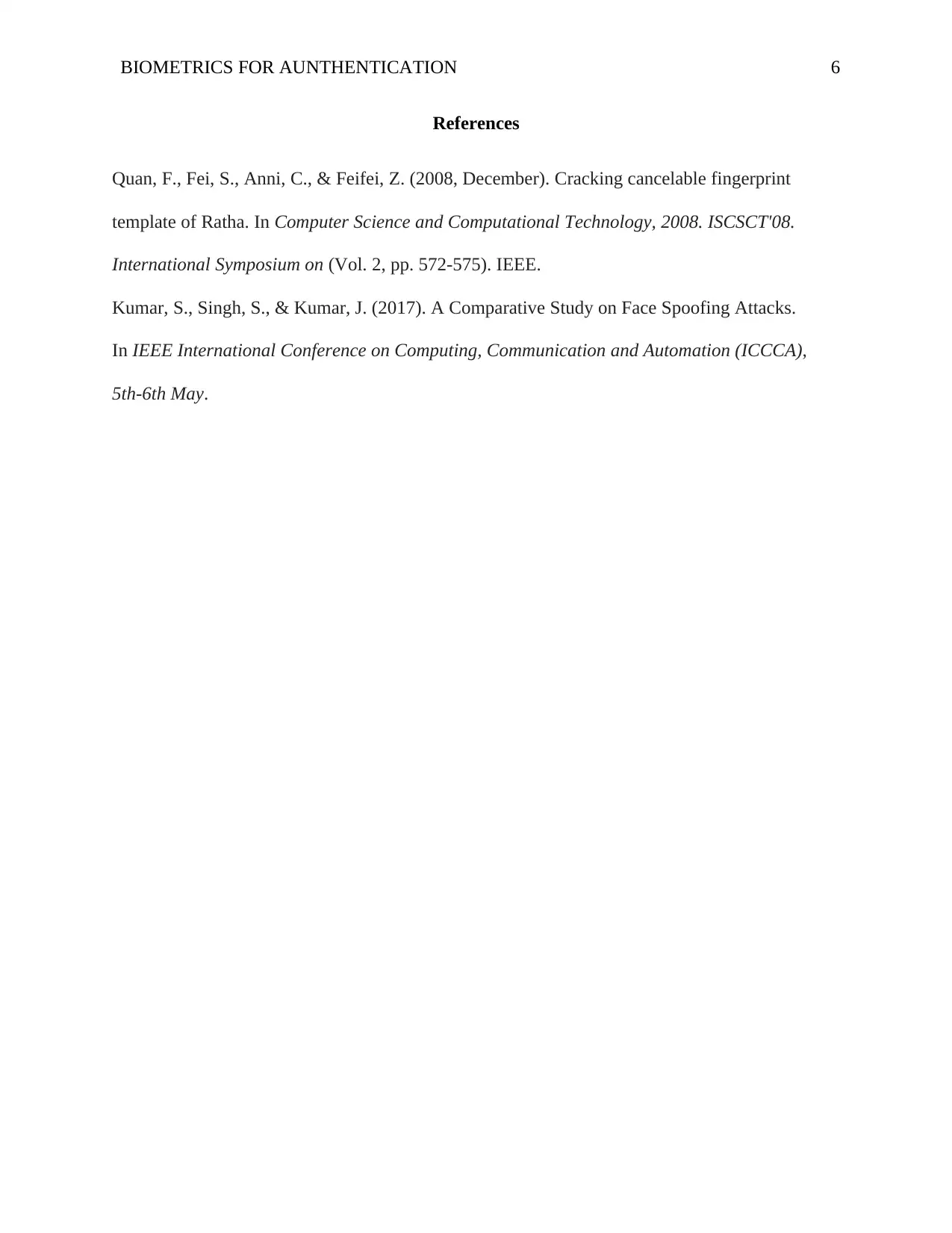
BIOMETRICS FOR AUNTHENTICATION 6
References
Quan, F., Fei, S., Anni, C., & Feifei, Z. (2008, December). Cracking cancelable fingerprint
template of Ratha. In Computer Science and Computational Technology, 2008. ISCSCT'08.
International Symposium on (Vol. 2, pp. 572-575). IEEE.
Kumar, S., Singh, S., & Kumar, J. (2017). A Comparative Study on Face Spoofing Attacks.
In IEEE International Conference on Computing, Communication and Automation (ICCCA),
5th-6th May.
References
Quan, F., Fei, S., Anni, C., & Feifei, Z. (2008, December). Cracking cancelable fingerprint
template of Ratha. In Computer Science and Computational Technology, 2008. ISCSCT'08.
International Symposium on (Vol. 2, pp. 572-575). IEEE.
Kumar, S., Singh, S., & Kumar, J. (2017). A Comparative Study on Face Spoofing Attacks.
In IEEE International Conference on Computing, Communication and Automation (ICCCA),
5th-6th May.
⊘ This is a preview!⊘
Do you want full access?
Subscribe today to unlock all pages.

Trusted by 1+ million students worldwide

BIOMETRICS FOR AUNTHENTICATION 7
1 out of 7
Related Documents
Your All-in-One AI-Powered Toolkit for Academic Success.
+13062052269
info@desklib.com
Available 24*7 on WhatsApp / Email
![[object Object]](/_next/static/media/star-bottom.7253800d.svg)
Unlock your academic potential
Copyright © 2020–2025 A2Z Services. All Rights Reserved. Developed and managed by ZUCOL.





